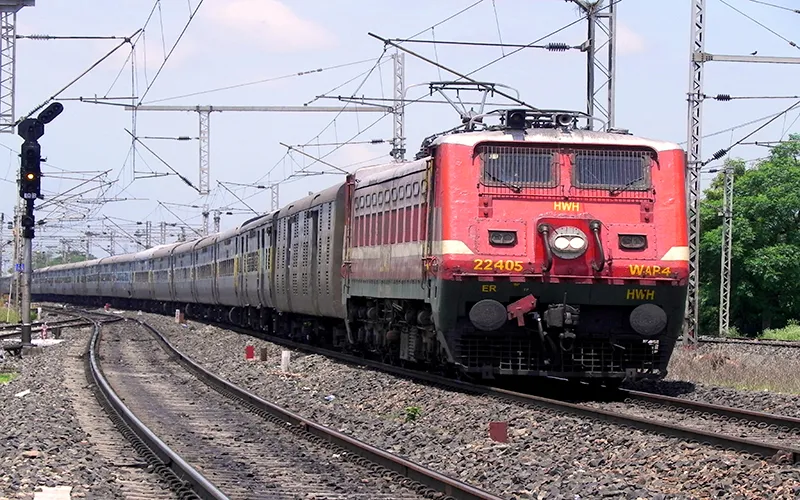Indian Railways remains one of the largest owners of land in the country along with the defence services and the port trusts. And yet, India has been unable to either free up the unutilised land for most part, nor has it been able to monetise it adequately.
The ministry of Railways concerned with optimising its land resources constituted Railway Land Development Authority (RLDA) on 31.10.2006, amended on 5.1.2007. In the years that it has been in existence, its Annual Report for 2013-14 reveals total receipts of Rs 510.47 crore was realised from commercial development of railway land at Sarai Rohilla, Delhi, Bangalore, Gaya and Multi Functional Sites at Katra, Jhansi, Cuttack, Bhuj, Jungadh, Somnath, Anand and Nadiad. The Report goes on to say that of this Rs 940.16 crore was transferred to the concerned zonal Railways after retaining Rs 5.04 as allowed margin money. Since this was mathematically impossible, the auditor CAG pointed out the error saying that the accounts not quite right. Closer examination found that the accounts had an opening balance of Rs 377.35 crore, earnings of Rs 510.47 crore and interest earned was another Rs 70.03 crore making the sum total Rs 957.85 crore. Of this Rs 957.85 crore, after retaining margin money of Rs 5.04 crore, Rs 940.16 crore was transferred out and the balance Rs 12.65 crore went to the Railways. Further, the Annual Report states that during 2013-14 no letter of award for commercial development of sites was given out by RLDA.
Variance
Sometime in March this year, Railways Minister Suresh Prabhu informed Lok Sabha that the largest employer of human resources in India has retrieved a total of 112.67 hectares of encroached land in the last three years.
Two years ago in September, in order to galvanise the business, international property consultant Knight Frank was roped in by the RLDA to market unused railway land parcels in southern and western parts of the country. In a statement issued by Knight Frank at the time, it said that, "Rail Land Development Authority has partnered with Knight Frank India to undertake its initiative of monetising unused railway land parcels in 53 locations across the South and West of India."Remember that this was a decision taken by the previous dispensation and the idea was that Knight Frank India would be responsible for conducting site visits, coordinating collaterals, expression of interest from developers, retailers and hoteliers, as well as managing the bid process.
RLDA began the process of inviting bids for commercial development of vacant railway land. Multi-Functional Complexes (MFC) would be developed for providing amenities to commuters including Budget Hotels at stations. RLDA has more than 120 sites pan India leased out to developers through an open bid process. Sites were offered on 30-45 years lease on upfront lease premium or Revenue Sharing basis through MOU to PSUs and through open bidding process to private sector.The status of the MFCs as per the RLDA website as of July 17, 2015 is typical of the way India functions. It is as follows - http://www.rlda.indianrailways.gov.in/view_section.jsp?lang=0&id=0,296,307,495.
In March, Mr Prabhu said that out of 4.58 lakh hectares of land available with the railways, 930 hectares or 0.20 per cent was under encroachment as of March last year. Significantly approximately 47,000 hectares of Railway land is vacant but is mostly in the form of narrow strips along the tracks, which is required for servicing and maintenance of tracks, bridges and other railway infrastructure.
Mr Prabhu said the vacant land which is immediately not required for operational purposes was utilised in the interim period for commercial development through RLDA to mobilise additional financial resources.
For sometime now, the Railways has been trying to jump start plans to monetise its land holdings in order to generate close to Rs 1000 crore of revenue annually, but this hasn't fructified for reasons well chronicled about the Railways where the wheels move slowly..
In what was perceived to be one of the most successful divestitures, real estate company Parsvnath Developers had paid Rs 500.86 crore instalment to the RLDA a couple of years ago against the 38 acres of rail land that it had bought for Rs 1,651 crore. Parsvnath had bought this land, located at Sarai Rohilla- Kishanganj in the national capital, from RLDA in 2010 through an auction. Till last reports, Pasvnath had paid Rs 1161 crore in three tranches for the land parcel. However, with the realty sector going through a downturn, the Delhi Sara Rohilla project has now been referred to the Arbital Tribunal. Other projects across the country are also facing litigation proceedings slowing things up.
In May, 2012, Mr Bharatsinh Solanki, then junior Railways Minister, informed parliament that the monolith generated revenues of about Rs 2,500 crore through leasing and licensing of land in the last three years. It earned Rs 1105 crore in 2011-12, Rs 732 crore in 2010-11 and Rs 649 crore in 2009-10.
At that point time, Railways reportedly had approximately 10.65 lakh acres of land, of which about 90 per cent was under Railway operational and allied usages. The total vacant Railway land mentioned then was about 1.13 lakh acre. Zone-wise details of vacant land then were: 6188 acres in Central Railway; 3792 acres in Eastern, 8620 acres in East Central, 4707 acres in East Coast, 9489 acres in Northern, 1079 acres in North Central, 14352 acres in North Eastern, 11718 acres in Northeast Frontier, 5953 acres in North Western, 5673 acres in Southern, 5557 acres in South Central, 4467 acres in South Eastern, 9659 acres in Southeast Central, 2255 acres in South Western, 17970 acres in Western and 1458 acres in West Central. Solanki had then said, "The vacant railway land is utilised for execution of various infrastructural projects for meeting future growth needs of Railways and include projects like doubling, traffic facilities, Rail Coach and Component factories etc."
These figures are at complete variance with what Mr Suresh Prabhu gave earlier this year, once again throwing into stark relief the level of opacity in the organisation. As with everything concerning the Indian Railways since Mr Lalu Prasad Yadav's five year tenure, all the numbers deceive, in fact they lie to such an extent that one doesn't know what the Railways owns or whether it makes money anymore on anything or what is required for its actual modernisation needs in financial terms and most vitally how cross subsidisation of passenger fares by freight hikes has eaten away the very innards of the organisation.
Confusion continues to confound all those who want Indian Railways to be restored to its erstwhile glory of providing comfortable and affordable travel across India. Given how the rest of the world has leap frogged ahead of India in its railway infrastructural needs, the comatose Railway set up, facing annual losses of Rs 26,000 crore (ball park), needs kick in the seat of its pants.
Start with the land assets, but be pro active.
(The writer is a Visiting Fellow at Observer Research Foundation, Delhi)
The views expressed above belong to the author(s). ORF research and analyses now available on Telegram! Click here to access our curated content — blogs, longforms and interviews.




 PREV
PREV

